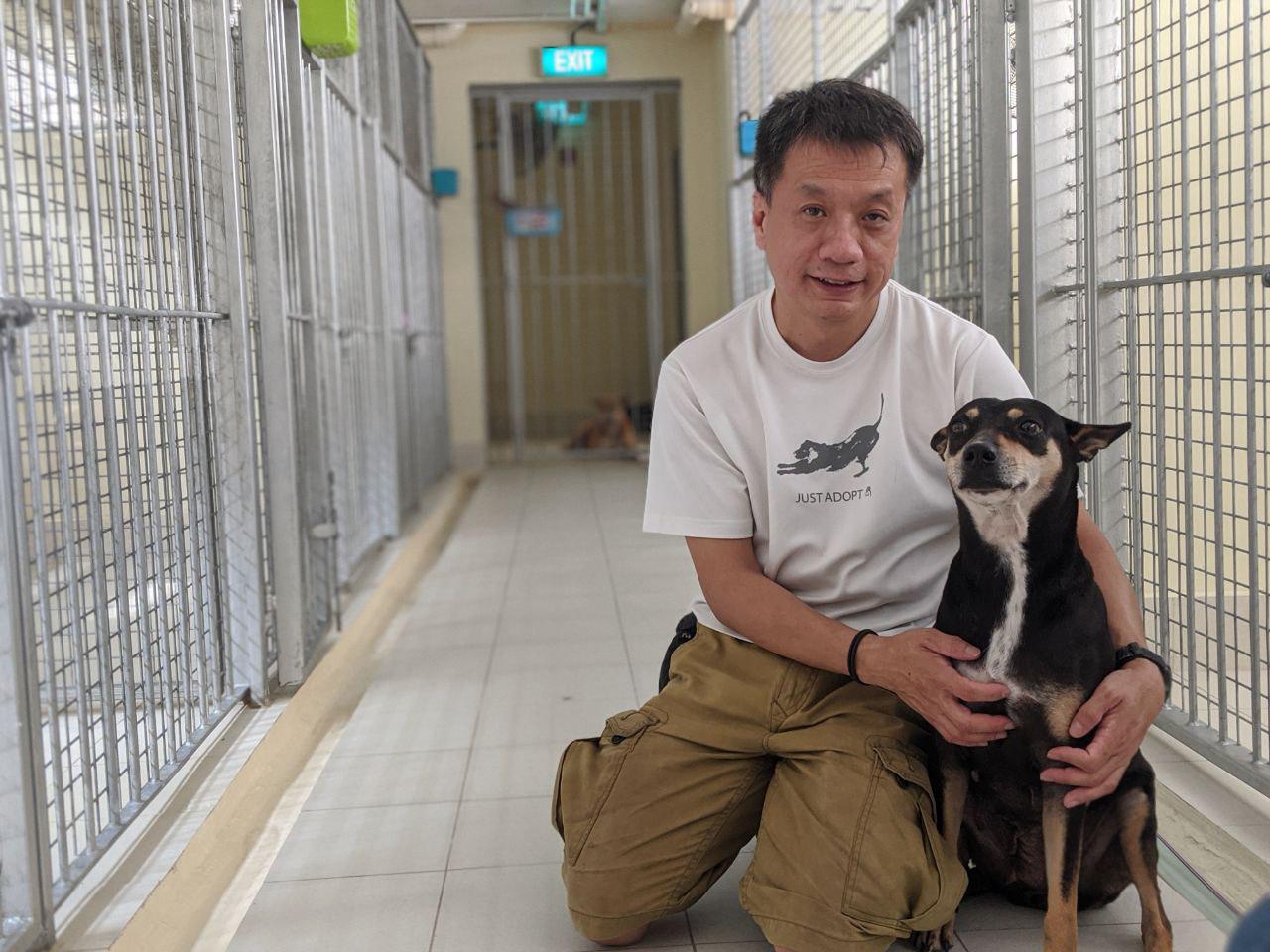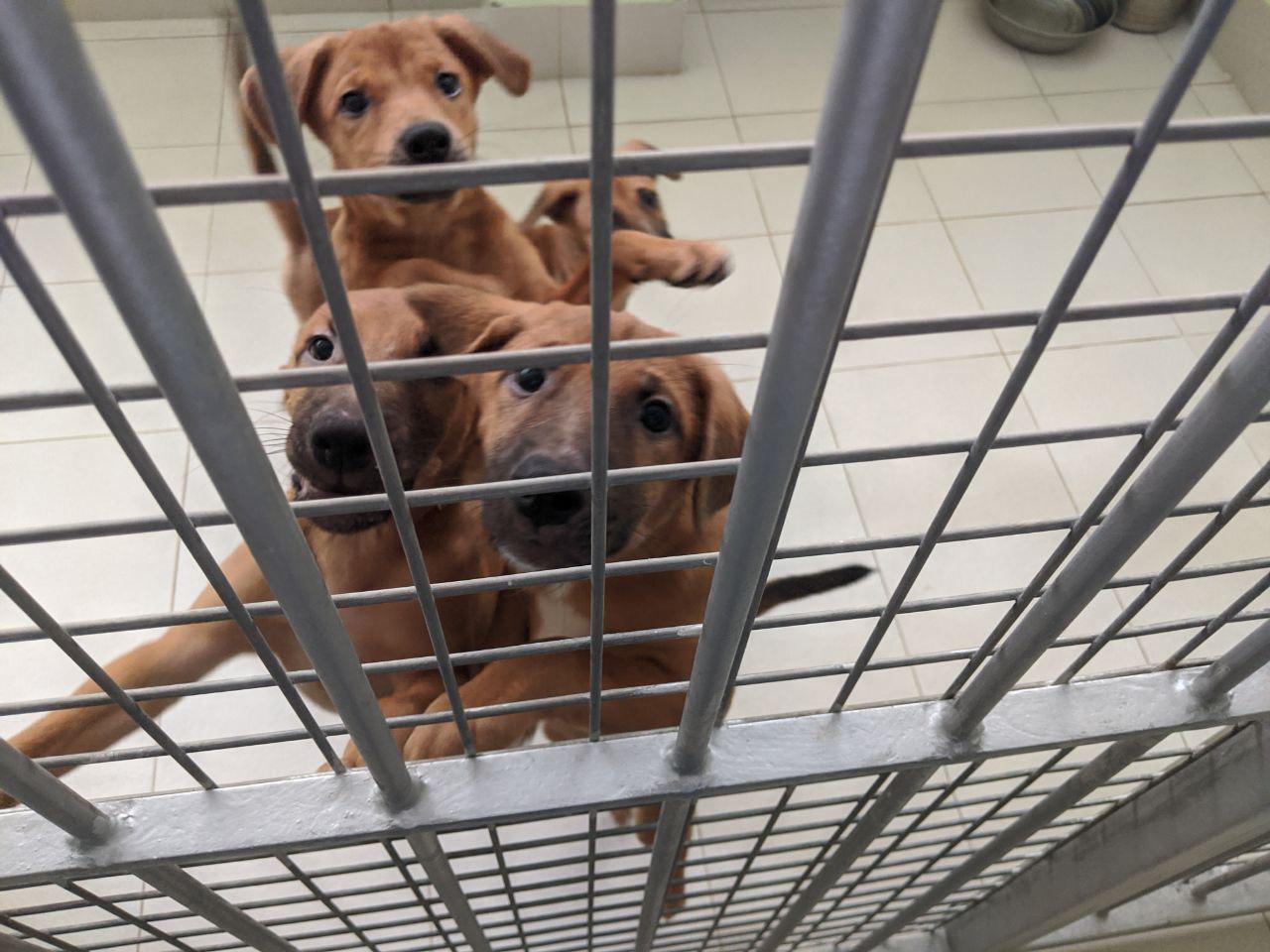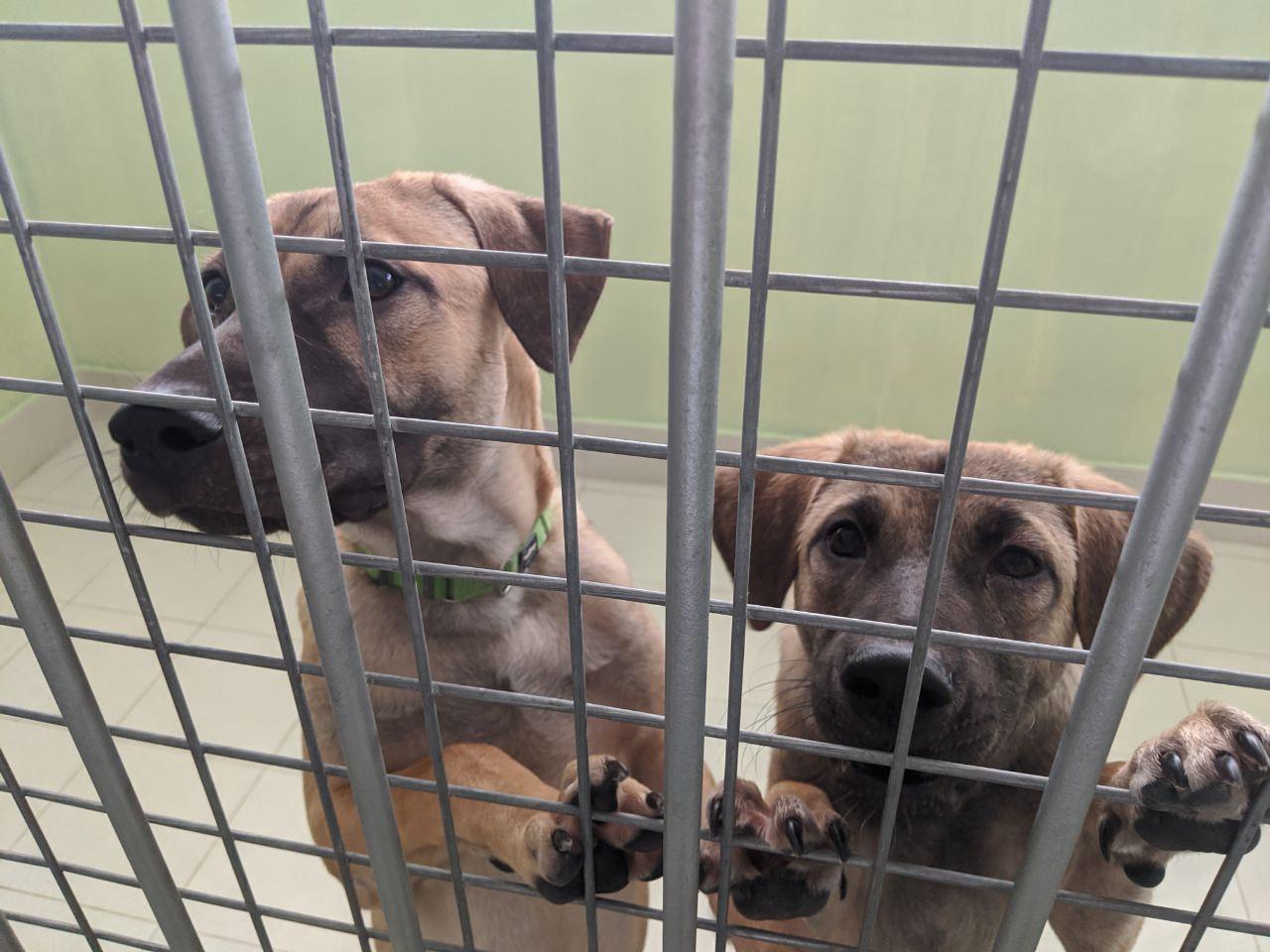Somewhere off Kranji is The Animal Lodge (TAL), a facility that houses animal welfare groups, independent shelters and animal farms.
So when I was there, it wasn't uncommon for me to walk past an alley with a cacophony of strays, perhaps wanting in attention or hoping I was there to bring them to their forever homes.
The Singapore Specials
But one sight I remembered fondly was when three little puppies ran towards 51-year-old Ricky Yeo, begging cuddles (or food).
"You see, these are the Singapore Specials," Yeo said.
 Yeo pampering the three little puppies. Photo by Fasiha Nazren
Yeo pampering the three little puppies. Photo by Fasiha Nazren
The term "Singapore Specials", I was told, was coined to prevent people from calling these locally bred dogs less desirable terms like "strays" or "mongrels".
As he smiled and continued entertaining the little doggos, I couldn't help but notice the fine lines forming on his face.
A result of running a shelter for these Singapore Specials for close to 20 years, I suppose.
Discovered the plight of strays
Yeo is the founder and president of Action for Singapore Dogs (ASD), one of the first few dog shelters in Singapore.
Close to 100 per cent of the dogs rescued by ASD are the Singapore Specials.
But why this breed, that is often overlooked than say, a corgi or a dachshund?
He said that he began to understand the plight of the strays when he started volunteering at Noah's Ark Natural Animal Sanctuary (NANAS), for three years in the late 90s.
Unfortunately, NANAS ceased operations in Singapore.
He explained:
"Raymund Wee (founder of NANAS) was forced to relocate to Johor, which left a void (in animal welfare) in Singapore"
No-kill policy
That's when he decided to fill the void.
In December 2000, he started ASD and wanted to do things differently from other animal shelters in Singapore.
Firstly, he wanted to help the strays as at that time, there were no other organisations apart from SPCA that was helping this group of dogs.
Secondly and most importantly, he also wanted to promote the no-kill policy, a policy which has since been followed by several other shelters in Singapore.
But running a dog shelter wasn't as easy as he thought it would be.
In ASD's earlier days, Yeo had to do almost everything himself as the organisation didn't have the means then to hire anyone.
"I had to do everything and that includes taking in the dogs, looking after them, vet care, administrative work, dog training, fundraising and even website maintenance."
Now, he is more than grateful for his group of volunteers and a core team of fewer than 10 individuals that help to keep the shelter running.
How much it costs to support 200 dogs
Take a seat before you find out how much it costs to run two shelters that house close to 200 dogs.
Yeo told me that it costs a whopping S$66,000 per month to run the shelter.
But how do they manage to find that much money every month?
In their earlier days, they would do everything to get people to know about ASD.
From baking cupcakes to selling collars, they have done it all.
But one thing that has done well since 2002 is their annual calendar sale, featuring pictures of the dogs that have been re-homed or fostered by ASD.
Fundraising, however, wasn't enough to cover the costs. Some of it was also paid for from his own pocket.
From software developer to dog trainer
Having been a full-time software developer for over 20 years, he left his job in 2012 so he could devote more time to the shelter.
To make ends meet, he currently works as a dog trainer, running between two to three sessions per day.
 Yeo with Baby, a Singapore Special. Photo by Fasiha Nazren
Yeo with Baby, a Singapore Special. Photo by Fasiha Nazren
"It's like stepping off a cliff for the first few years. But at least what I'm doing now is aligned with running ASD since everything I do is about dogs," he joked when I asked if he felt any drastic changes to his income.
No good days
At this point, some people may think that it's a noble and novel job for a dog lover to be surrounded by dogs all day.
The reality, however, is quite the contrary.
He would always tell people that doing what he does has no glamour, money nor glory.
Yeo even joked that his line of work has no good days, only bad and worse ones.
The toughest part of his career is when a dog under ASD's care passes on.
"When we give them the best medical attention and they don't survive... That hits us hard. Sometimes we have to make the difficult decision to put a dog to sleep after all medical treatment have been exhausted. We don't take life lightly, dogs are sentient beings too."
But most times, it is not the dogs that are a cause for concern for Yeo and his team.
"We used to have a hotline to facilitate adoptions and do quick screenings for adopters but 90 per cent of all calls came from people who wanted to 'surrender' their dogs instead."
Some rescue efforts that he has publicised on social media has also received criticism, with the public perceiving that he is doing what he does for the glory and money.
In other cases, people would have things to say about the rescuers' decisions.
"When we write on Facebook that a dog is undergoing a certain treatment, some people would comment 'Why don't you do that treatment instead?' or 'Oh my God, you're spending S$5,000 on a stray dog? Why not spend it on a human instead?' We get this all the time."
Although the comments have affected his mental health, he doesn't let it falter his beliefs.
"To face this every day, it took a toll on me. But when you understand that they are sentient beings and they need help, it helps you to stay true to the cause."
To the 3,000, it mattered
Ultimately, what keeps Yeo and ASD running are the dogs themselves.
Even though he did mention that there's "no money" to what he does, he also stressed that money can never buy these life experiences.
Since its inception, the organisation has helped a total of 3,000 dogs to either find a good home or at least get them sterilised.
"In the whole scheme of things, it may not present a big number. But to the 3,000, it mattered a lot."
 Photo by Fasiha Nazren
Photo by Fasiha Nazren
One incident that he remembers to this day was the rescue case of an abandoned dog.
According to him, the team discovered the dog in a manhole after a member of the public alerted them to barks coming from below.
When they finally managed to pry open the manhole cover, they saw a very skinny Boxer pup.
He said: "He was totally emaciated, probably just drinking the drain water to survive. So we nursed her back to health and eventually found a good home for her. To see them find a good home where the family loves them... That is just priceless."
Reducing dog population in Singapore
ASD currently has a shelter in TAL, which is a government-built facility.
Compared to their Lim Chu Kang shelter that can house close to 100 dogs, the shelter can only accommodate for 60 of their dogs.
 Photo by Fasiha Nazren
Photo by Fasiha Nazren
However, Yeo doesn't see the small space as an obstacle.
"The space may be small, but at least the maintenance of the shelter is easier and its cooler for the dogs too."
The lack of space isn't a bad thing for him as, after all, the goal is to reduce the dog population in Singapore.
ASD is a partner of the Trap-Neuter-Release-and-Manage (TNRM) program, which was launched in December 2014 to manage the dog population in Singapore.
"The longterm plan is to reduce the dog population in Singapore. We also don't want to keep these dogs cooped up in the shelter forever. As TNRM kicks in, hopefully we will see less dogs."
"For as long as my weary body and mind can continue"
As Yeo is inching towards his 50s, I couldn't help but to ask how long is he going to continue doing what he does.
After a short laugh, he said: "For as long as my weary body and mind can continue."
He is still hoping to find someone to take over the mantle but he also believes that a lot of people do not want to do what he does, and for the right reasons.
"I've not found the right person yet. It is not a job that anyone can do, even if you have the heart for it. We are a pragmatic society. Will we ever do something for nothing over a long period of time?"
But while he waits for the right person to come around, Yeo and the other animal welfare groups in Singapore will do all they can to help the Singapore Specials.
Because if not for them, then who?
Top image by Fasiha Nazren
If you like what you read, follow us on Facebook, Instagram, Twitter and Telegram to get the latest updates.
